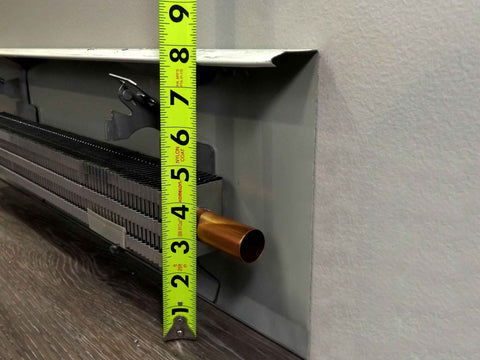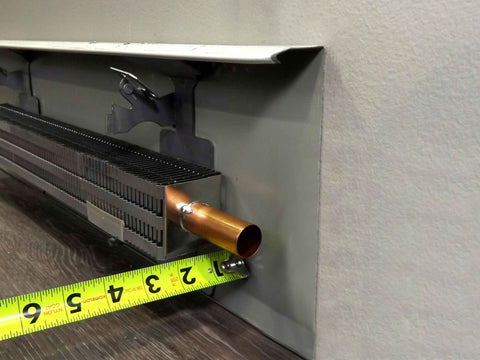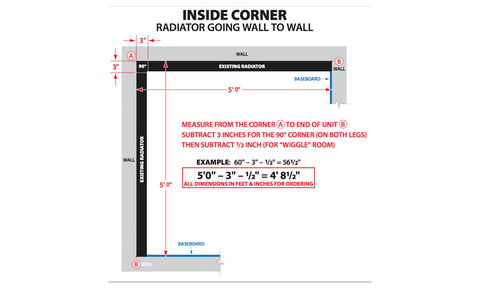Homeowners and property managers want heating systems that stay safe, work efficiently, and look good in any room. Baseboard heater covers check all three boxes by adding protection, improving airflow, and offering a cleaner appearance. Our expert guide will answer your top questions about baseboard heater covers, helping you understand if you really need them and which materials work best.
Are Baseboard Covers Safe?
Safety comes first when you think about any heating system, and baseboard heater covers are no exception. A quality cover acts as a protective barrier between the heater’s sharp metal fins and the room itself. This barrier reduces the chance of accidental cuts, scratches, or burns when someone gets too close. Families with small children or pets especially benefit from covers since curious hands and paws naturally explore low areas of a room.
Beyond physically protecting the heater, covers also help prevent clutter or debris from falling inside. Small objects, dust, and pet hair can block airflow and create hot spots that make the heater run less efficiently or cause damage. A fitted cover limits this risk while allowing heat to move into the room.
You’ll also find that modern covers follow strict safety standards. Manufacturers design them with materials that resist warping, cracking, and overheating. If you shop from a reputable brand, you gain peace of mind knowing your heating system will stay reliable and safe for everyone in the space.
Does My Baseboard Heater Need a Cover?
While baseboard heaters work without covers, leaving them bare often creates problems. The exposed fins on a heater collect dust quickly, which reduces efficiency. They also look unfinished and can make an otherwise neat room appear cluttered. A cover solves both issues by making the heater look polished and shielding the fins from dust and accidental bumps.
For property managers, covers also provide practical advantages. Tenants are less likely to damage a covered unit during everyday activities like vacuuming or rearranging furniture. Without covers, bent fins and scratches frequently appear, leading to performance problems. By adding covers, you reduce repair costs and protect your investment over the long run.
Homeowners often notice that baseboard heater covers make their homes feel warmer and more comfortable. The covers guide airflow so heat spreads evenly throughout the room instead of rushing straight up the wall. This steady flow of warm air helps every corner of the space stay cozy.
What Is the Best Material for Baseboard Heater Covers?
Choosing the right material directly affects performance and durability. Most covers come in either steel or aluminum, and both materials bring unique benefits. Steel offers strength and resists dents for the long term, making it ideal for high-traffic areas. Aluminum resists rust and weighs less, which helps when installing or removing covers for cleaning.
Some homeowners consider plastic alternatives, but these options often warp over time and struggle to withstand repeated heat exposure. They may work as a budget solution in the short term, but they rarely last as long as metal choices. For long-term results, steel and aluminum remain the top picks.
When deciding, think about your specific environment. For coastal homes or damp basements, aluminum makes sense since it resists corrosion. For rentals or busy households where furniture gets moved often, steel better protects against the bumps and scrapes of daily living.
Either way, upgrading to quality baseboard radiator covers ensures you won’t constantly replace them. Style also matters, and both materials come in clean designs and neutral colors that blend with your home's trim and flooring.
Do Baseboard Heater Covers Get Hot to the Touch?
Many people worry about burns when adding covers, but most designs avoid dangerous surface temperatures. A baseboard heater works by pulling cool air in through the bottom, heating it over the fins, and pushing warm air out through the top. Covers allow this natural convection process to continue without trapping extreme heat.
That said, covers will feel warm when the heater runs. This warmth usually stays safe to touch briefly, which matters in homes with children. Manufacturers design covers with airflow slots that keep the surface from reaching unsafe levels. Still, it’s best to avoid leaning against them for extended periods.
For property managers, the reduced risk of accidental burns reassures families who rent. If you notice a cover that feels too hot, it may signal that dust is blocking the vent. Clean and maintain both the heater and the cover to fix the issue and keep your heating system safe and dependable throughout the season.
Do Baseboard Covers Have Overheating Protection?
Baseboard heater units include built-in features that protect against overheating, but the covers themselves do not. The internal thermostat and safety switch in the heater shut the system off if it reaches unsafe temperatures. The cover, meanwhile, plays a supporting role by helping air flow remain steady so the unit can operate normally.
When installed correctly, a cover doesn’t block heat or interfere with safety switches. Instead, it helps warm air circulate through the top vents. This stronger airflow lowers the chance of overheating and keeps the unit running efficiently. You should never place objects like furniture, curtains, or rugs against a covered heater, as this creates a real risk of trapped heat.
For homeowners and property managers, understanding this distinction helps. Covers don’t provide their own way to protect against overheating, but they support the system’s safeguards by ensuring the heater can breathe properly.
How Can I Make My Baseboard Heater Covers More Efficient in Winter?
Cold winter months put every heating system to the test, and the way you care for your covers determines whether they perform better or worse. Keeping them clean has the greatest impact, since dust and pet hair clog vents and block airflow. Regularly vacuuming around and inside the covers keeps warm air moving freely. Removing the covers a few times each season to wipe down the fins also helps the heater run more efficiently.
Placement matters as well. Avoid blocking covers with furniture or heavy drapes. Even partly blocking them reduces how well air circulates and forces the heater to work harder. Keeping the area around heaters clear allows the room to warm more quickly and evenly. In multi-unit properties, reminding tenants of this simple step can prevent them from complaining about uneven heating.
Upgrading older covers also noticeably improves heating. Newer models feature vent designs that spread heat more effectively, helping rooms stay warm without extra energy use. Property managers often find that replacing outdated covers across several units lowers overall heating costs. Pairing these improvements with other small steps, like sealing drafts around windows and doors, creates a more efficient system and keeps indoor spaces comfortable all winter long.
Comfort and Protection Made Simple
Baseboard heater covers combine safety, efficiency, and visual appeal in a single upgrade. For homeowners, they create peace of mind and enhance the aesthetic appeal of living spaces. For property managers, protecting heating systems from damage and reducing maintenance costs are key benefits. Now that we’ve answered your top questions about baseboard heater covers, you know that the right choice protects your heaters and enhances comfort and style throughout your property. Contact our team to help you find the perfect baseboard covers for your property.























